|
– Page 1 of 3 –
| “If you don’t like Laurel and Hardy, you are no friend of mine.” |
| Actor and keen Laurel and Hardy fan, Mark Hamill* |
For some now inexplicable reason I never got around to listing my favourite disc releases of 2024 at that year’s end as I usually do, but know for a fact that Laurel & Hardy: The Silent Years – 1927, Eureka’s glorious two-disc collection of silent films featuring Stan Laurel and Oliver Norvell Hardy, would have not only been on it, but somewhere near the top. As a lifelong fan of Stan and Ollie’s work, I was looking forward to covering that release ever since I read about it, but the review discs landed on my doormat while I was holidaying in Japan. That wasn’t going to stop me, and on my return I neglected a slew of other discs that were screaming for my attention to focus exclusively on that release. The completed review was lengthy and detailed enough to need spreading over three web pages and ended up being posted over a month after the set was released. Now Eureka has delivered a follow-up collection featuring films made by Stan and Ollie over the course of 1928, and once again the review discs reached me at an awkward time in my personal life, but so thrilled was I by this set that I knew I’d have to once again sideline other discs to give it the attention it deserves. The resulting review is of a similar length to its weighty predecessor and is once again being posted almost a month after the release date, a display of punctuality tardiness on my part that I’m sure regular visitors to the site are used to seeing by now.
While the 1927 collection charted the gradual evolution of Stan and Ollie’s onscreen personas, their partnership and even their screen personas are effectively established from the first film onwards in this new set. Aside from a single interesting and not fully successful experimental blip, what we see over the course of the ten films in this set is the two men, primarily under the guidance of Stan and regular supervising director Leo McCarey, refining their characters and their comedic style and bringing them steadily closer to the sound era incarnations we came to know and love.
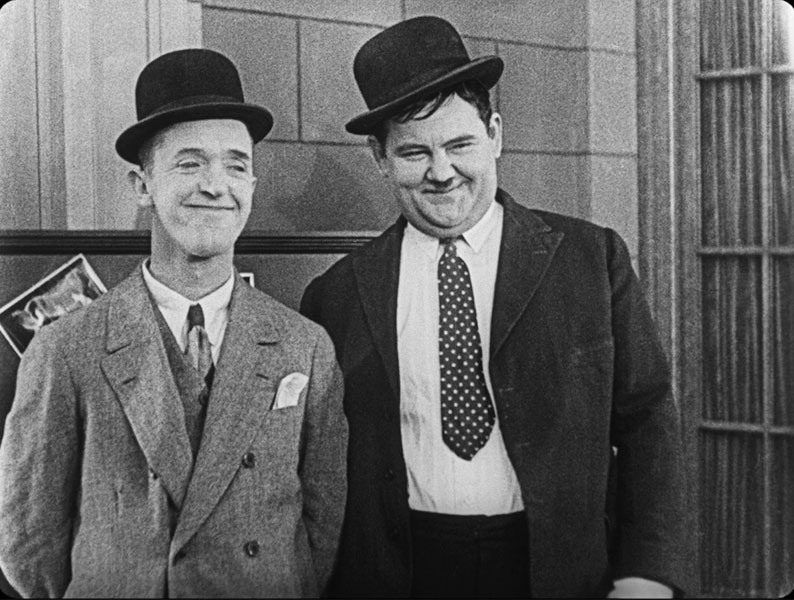
As before, I’ve elected to review each of the films individually rather than provide a more generalised overview of the collection, and have covered them in the order in which they appear on the two discs. As is our way, I’ve also detailed each of the special features, which include commentary tracks for each of the films, and have again spread the review over three pages for easier access to individual films and sections and (hopefully) quicker loading times. If you’re impatient to know whether I enjoyed this collection as much as the first, then I’ll save you some time and assure you that I absolutely adored it, not just for the films but also for the excellent special features. Thus, if you were a fan of the 1927 collection, you’re going to feel the same way about this one too. Read on and I’ll hopefully convince you why.
THE FILMS – 1-5
| LEAVE 'EM LAUGHING (1928) |
|
Although the title of the first film in this collection might seem to be the mantra for Stan and Ollie’s comedy (and that of any screen comedian worth their salt, of course), what it specifically refers to here is the side effect of nitrous oxide. For those new to this substance, nitrous oxide is gas that first found popularity as a recreational drug, but later found new life as a medical anaesthetic and has since become more widely known as a propellant for turbocharging cars. In recent years it has once again become popular with those looking for a quick high, one whose health risks have seen it classified in the UK as a Class C drug under the 1971 Misuse of Drugs Act. The euphoric sensation that its inhalation can produce saw it nicknamed “laughing gas” by celebrated 18th century British chemist and inventor Humphry Davy, which proved a gift to comedy film makers, who took that nickname and ran with it like hyperactive cheetahs. In comedy movies, nitrous oxide doesn’t get you high, it makes you laugh hysterically and find everything that happens to you and those around uproariously funny.
The plotline of Leave ‘Em Laughing is straightforward enough. Stan has a mother of a toothache, and his groans of pain are keeping Ollie awake. Following a doomed attempt to ease his friend’s suffering with a warm water bottle that leaks its contents into their bed, Ollie attempts a trick that has passed into legend but that I still struggle to believe was ever successfully put into practice in the real world. It involves tying one end of a piece of string round the offending tooth and the other around the handle of an open door, which is then slammed shut by a willing accomplice, the aim being to sharply pull the tooth in question from your jaw. Unsurprisingly, when Stan and Ollie try this it does not go well, and so the following day they head to the office of a dentist (Jack Lloyd) whose patients either attempt to flee just seconds after entering the surgery or are carried out on a stretcher buckled up and unconscious, none of which does much to calm the already rattled Stan’s nerves.

To say that much of what defines Stan and Ollie’s onscreen characters was already in place by the time they made Leave ‘Em Laughing would be an understatement, as so many signature elements of their later sound films are on display here that I genuinely had trouble keeping count. If you know your sound era Laurel and Hardy films, try this lot for starters:
- Stan and Ollie share and apartment and sleep in the same bed;
- Stan expresses pain by looking as if he’s about to burst into tears;
- When Ollie goes to the bathroom to fill a water bottle, he bangs his head twice on the same cabinet door and twice treads on the same tack that is for no logical reason is sitting with its sharp end upwards on the floor, and the second instance of both gags is caused in part by Ollie’s annoyance at the first;
- When he thinks he’s pulled the tooth but has actually wrenched the doorknob from the door, Stan spreads his hands in a gesture of satisfied completion and flashes his signature wide grin;
- As their annoyed landlord (played by Stan and Ollie regular Charlie Hall) goes to leave the apartment after balling them out for making so much noise, Stan kicks him in the behind, and when he turns round he assumes that Ollie was to blame and kicks him in response, launching a brief tit-for-tat battle that ends with Stan sending the landlord into a daze with the softest of punches to the jaw, a gag he would recycle in From Soup to Nuts;
- When Stan gets a shock, his hat flies into the air;
- When the unconscious Stan is finally forced into the dentist’s chair, Ollie’s attempt to push a raised leg down prompts the other one to rise in response, as if the two are mechanically connected;
- Ollie’s attempt to calm Stan by showing how easy it is to sit in the dentist’s chair results in him being mistakenly gassed and losing a tooth instead, prompting Stan to look hopelessly at the camera and Ollie to explore the new gap in his mouth with a slowly evolving expression of dismayed realisation;
- When they leave the dentist’s office they do so in their favourite Ford Model T car;
- A parting gag sees them drive into a puddle that is, for not logical reason, a couple of metres deep, into which they then sink.
The remnants of their earlier, more slapstick-oriented films is briefly visible when the dentist furiously wrestles with a fleeing patient on the floor of the waiting room, a sequence whose funniest aspect is the reception nurse (Dorothy Coburn), who carries on working as if this sort of thing happens ten times a day, which it probably does if what we see here is anything to go by. Once the boys have both been accidentally gassed, the inventiveness of what has gone before dissolves a little into an overextended gag in which they cause a traffic jam because they can’t stop laughing. This brings them into conflict with an increasingly frustrated traffic cop played by former boxer turned comedy character actor Edgar Kennedy in his first of many such roles in Laurel and Hardy films, two of which he also directed.
| THE FINISHING TOUCH (1928) |
|
Stan and Ollie here are cast as finishers, craftsmen who specialise in completing the construction of those American wooden framed and walled homes that seem particularly popular with silent and early sound era comedy filmmakers. Want to guess why? Offered the then princely sum of $500 by a homeowner (Sam Lufkin) if they finish his currently half-built house by next Monday, Stan and Ollie set to work, and it will come as no surprise that a series of often violent mishaps ensue. In a further refining of their screen personas, Ollie repeatedly suffers physical injury due to the blissfully unaware Stan’s dim-wittedness, and he shares his despair with us via a series of long-suffering looks at the camera, a complicity with the audience that would become one of their most recognisable traits.
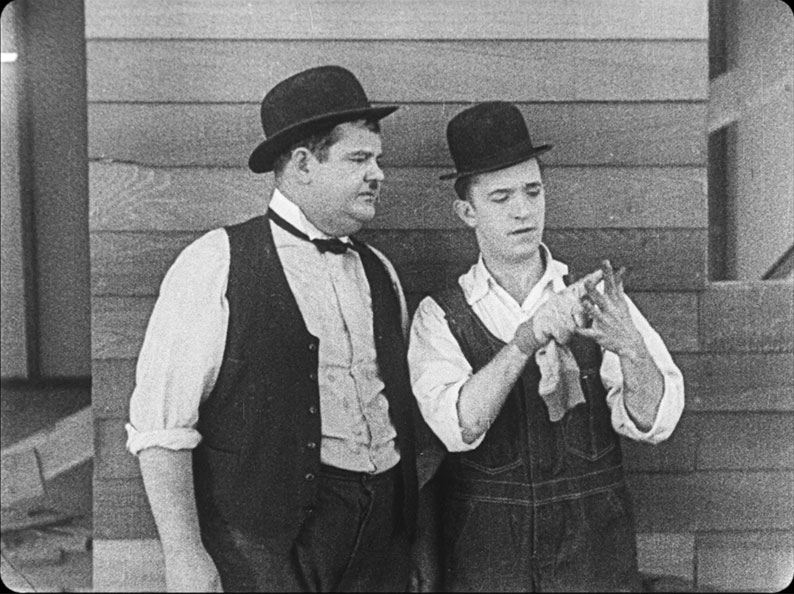
Two supporting players from Leave ‘Em Laughing reappear in similar roles here, with Dorothy Coburn cast as an irritated nurse at a nearby sanatorium (spelt ‘sanitarium’ here) who asks a cop played by Edgar Kennedy to tell the boys to not make so much noise. It’s here that one of the most memorable lines from Stan and Ollie’s 1930 Brats gets its first outing when the cop says, via an intertitle, of course, “If you must make a noise, make it quietly.” The unfortunate cop then becomes the target of even more physical injury and ignominy than Ollie, the cumulative effect of which eventually reduces him to tears. I hate to think what would have happened to the boys if just one of these accidental assaults was visited on the gun-toting American cops of today.
The telegraphing of gags from the previous film continues here, and although the payoffs are often inevitable, they also have a sometimes unexpected edge. A favourite example sees Ollie take a tumble whilst gluing on roof slates, only for the glue to then also fall, followed closely by the slate pile, all of which land on and stick to the unfortunate policeman, leaving him looking like a bargain basement Transformer robot. I was a little bemused by the twice repeated gag that has Ollie carry a handful of nails by stuffing them in his mouth then each time taking a sharp fall and swallowing the lot. Quite aside from the insanity of stuffing a wadge of sharp spikey metal objects in your mouth – seriously, was that ever a real world building site practice? – the fact that Ollie makes the same internal injury-causing mistake twice more may be one of the dumbest things his character has ever done, and smart decisions are not something these two are exactly known for.
There’s a nice bit of unforced slapstick when Stan attempts to fit a window frame that slowly comes apart board by board, and an old favourite music hall gag has him walk past the cop carrying the front end of an unfeasibly long wooden board that he is also at the tail end of. There’s also an implied audio gag after the angry nurse has punched both Stan and Ollie in the stomach, which causes Ollie’s hat to jiggle and Stan’s to fly skyward. As she leans down to pick up a hammer with which to continue her assault, Stan tears a sheet of sandpaper in half, prompting her to meekly retreat in the belief that the rear of her uniform has split. Interestingly, both of the included music scores accompany this moment with a tearing sound effect, but it works fine without it. No prizes are on offer for guessing what happens to the house at the end, with the landing of an animated bird on the chimney triggering a partial collapse, which prompts a stone-throwing battle that concludes with a destructive payoff that the faulty brakes on Chekov’s Delivery Van really should have had me anticipating earlier. Not the boys’ most sophisticated silent, but a fun one with some nicely executed slapstick moments, and that lays some notable groundwork for the films to come.
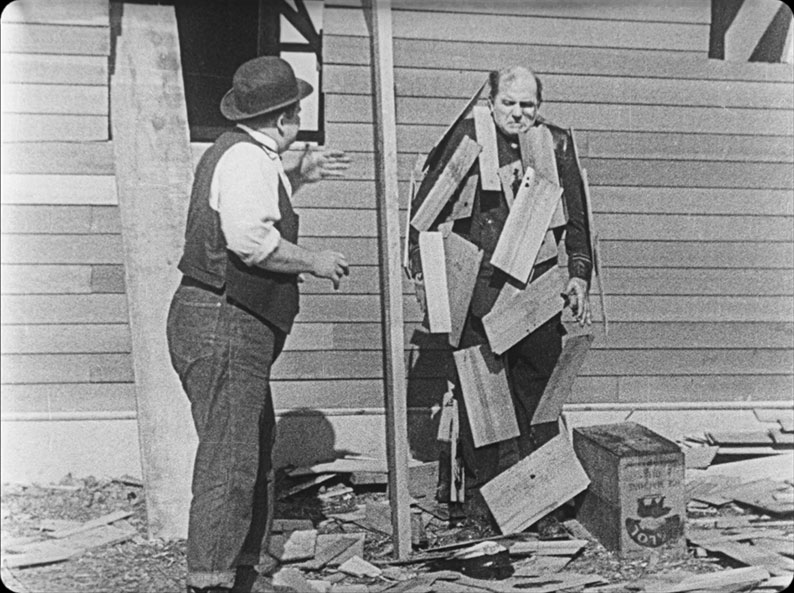
The score for this one was the work of one of the regular composers for this series, Neil Brand, but you can also choose to watch this one film with what the menu describes as an Alquist score, which I presume is the name of the composer. Apologies for my unfamiliarity with them and their work, whoever they may be, but I’m not a big music guy these days. Although also an orchestral piece (to be clear, we’re talking small orchestra here), the Alquist track has more of a Looney Tunes cartoonish feel than the more traditional Neil Brand score, complete with musical sound effects for the grabbing of objects, falls, collisions, assaults and the like. If you’ve ever thought of Stan and Ollie as the Road Runner and Wile E. Coyote, this track may well be for you. Personally, I’m happy with the Brand one.
Wannabe socialite Mrs Culpepper (Anita Garvin) decides to throw a dinner party for the local well-to-do, but has left it a bit late to hire agency butlers, and thus has to make do with a pair of railroad café servers, who are played, of course, by Stan and Ollie. Unsurprisingly, chaos ensues.
A sign of the turmoil to come occurs just seconds after our intrepid butlers arrive at the house when they get into a tit-for-tat battle with each other over the protocol of wearing of hats when indoors, which prompts the maid (Edna Marion) to role her eyes when presenting them to Mrs. Culpepper. When the hostess then walks off to join her guests, Ollie immediately lands himself in the bad books of her husband (Tiny Sandford) by remarking that she is “some wiggler” in reference to the sway of her hips as she walks. It’s once the two men reach the kitchen that their defining combination of clumsiness, misunderstanding and false pomposity really kicks in, as Stan unwittingly knocks Ollie’s hat into the soup, then uses his partner’s insistence that headwear should not be worn inside the house to get into an argument with the chef (Otto Fries) over his refusal to remove his chef’s hat. This verbal conflict quickly escalates into a physical altercation that sees them breaking multiple plates over each other’s heads. Both performers really go for it here, with Stan and the chef grabbing a whole pile of crockery to smash on their opponent’s craniums, which must have been painful even with plaster breakaway props. Ollie then delivers his own delightfully self-important take on the gag when he picks up an ornate porcelain serving dish and flashes one of his cutely confident smiles to the maid, then falls arse-over-tit on a slippery patch on the floor, spinning as he falls to shatter the dish with his chest. It’s quite a stunt for a man of Ollie’s bulk. He tries to laugh it off with a childish grin and the cutesy line, “I faw down,” which will be repeated and elaborated on later by Stan and is even the title of the final film in this set.
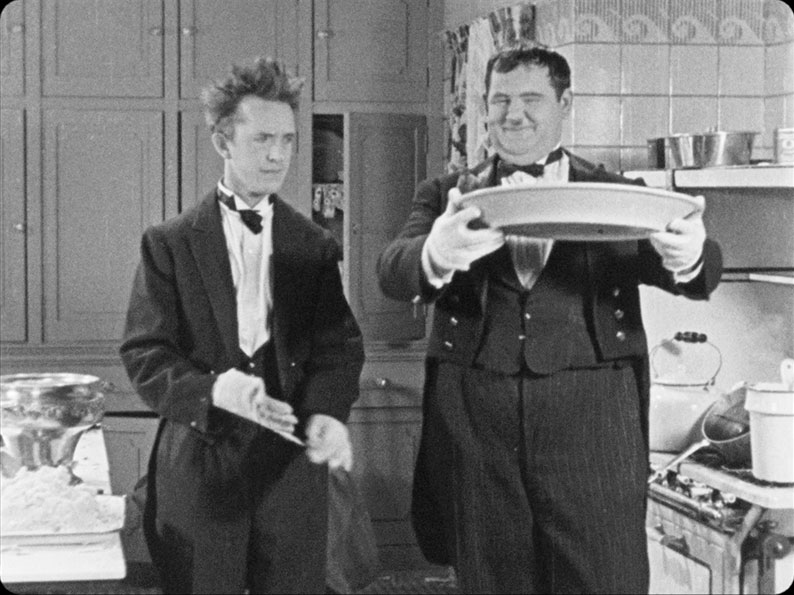
What follows is an enjoyable collection of slapstick buffoonery, much of which is in the recognisable Stan and Ollie style, with Stan dozily holding a cauldron of soup at an angle that allows its contents to stream out onto Ollie’s foot, something the distracted Ollie is typically slow to acknowledge and react to. This is followed by a prime example of the duo’s signature telegraphed gags, as we watch one of Hollywood’s most talented dogs peel a banana and leave its skin on the carpet just as Ollie picks up the sort of oversized cake that only has one function in comedy films, which it fulfils seconds later when Ollie slips and falls face first into it. For other comedians, that would have been the whole joke, but by this point the duo already understood the potential of the lingering reaction shot. Rather than cutting away, the camera remains fixed on Ollie as he slowly comes to terms with what has happened, shares a “can you believe this?” look at the camera, sits up and ineffectually tries to brush off some of the cream that has caked his tuxedo, daintily removes his gloves and wipes his eyes, before slowly getting to his feet.
This was the first of two Stan and Ollie films directed by favourite supporting actor Edgar Kennedy, who by this point was no newcomer to the craft and had 17 other directing credits under his belt. He does a solid job here, and even puts a personal signature on the film with two unexpected tracking follow shots. An extended sequence that has Anita Garvin chasing a wayward cherry round a plate with a spoon was recycled from a more elaborate version performed by Stan in the previous year’s The Second 100 Years, but here it interconnects with a running gag involving a tiara that repeatedly slips forward to cover Garvin’s eyes. There’s also an almost musical hall vibe to the telegraphed gag about Stan being told to bring in the salad ‘undressed’, which is nonetheless given a Stan and Ollie makeover by having Stan pull his crying face at the prospect, to which the maid responds by assuring him that she always serves it that way, to which a startled Stan suggestively asks, “What kind of party is this?”
| YOU’RE DARN TOOTIN’ (1928) |
|
Here Stan and Ollie are the worst musicians in an orchestra whose conductor (a highly animated Otto Lederer) is leading what is supposed to be his farewell concert, and quite how they’ve lasted this long is a mystery. They stand up when everyone else sits down and vice versa and completely miss their respective cues, forcing the conductor to pause the performance to walk over and berate them. There’s a lovely bit of physical comedy involving Stan’s repeatedly collapsing clarinet, and when his score sheet is blown off its stand by an overenthusiastic trombonist and under the conductor’s stamping foot, he convinces Ollie that it’s his score that has been blown floorward. Of course, every time Ollie tries to grab it the conductor steps on his hand, and once he has paused the concert in order to retrieve it, a further argument with Stan about whose score is whose escalates into a brawl that sends the entire orchestra tumbling to the floor in succession like a line of falling dominoes.
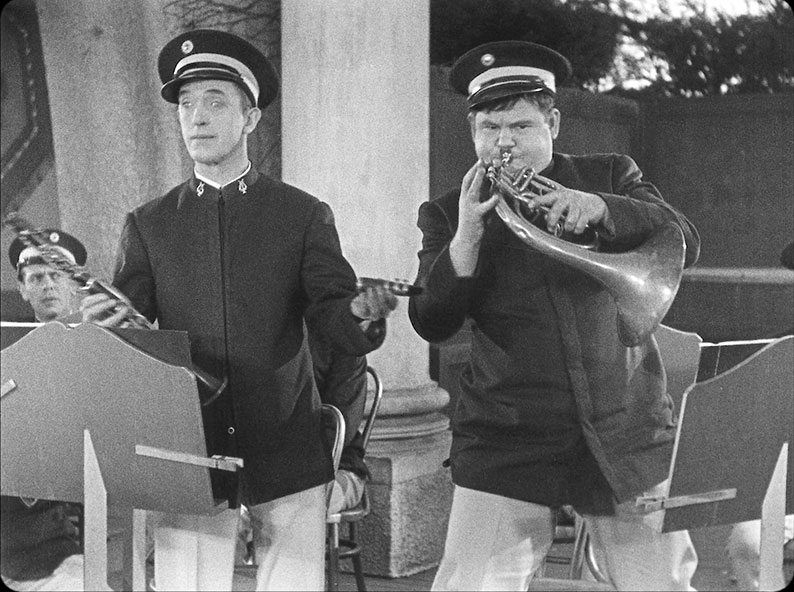
Sitting down for breakfast at their boarding house the following morning, they’re left a note by their fearsome landlady (Agnes Steele) demanding the payment of 14 weeks back rent, and when a young tyke (Monty O’Grady) who was at the previous night’s concert amuses himself by revealing that they were both fired for their shenanigans, they’re booted out of their lodgings and try to raise money by busking in the street. This quickly brings them into conflict with an intolerant policeman (Christian J. Frank), and eventually a whole string of irate individuals when an argument between the two now homeless men explodes into physical conflict.
Fans of Stan and Ollie’s sound era films should quickly feel at home here, with their failed attempts at busking and accidental wrecking of their instruments later recycled in their 1930 gem Below Zero, although fate leads them down an altogether more complicated path in the later film than the slapstick mayhem that develops here. A fair few favourite gags are road-tested or repeated: uncooperative salt and pepper pots whose heads are unscrewed by Stan then empty their entire contents into Ollie’s soup; open manholes into which Stan and Ollie drop objects or unwittingly tumble bring them into conflict with the men working beneath them; the duo lose and then mix up their respective hats; Ollie looks at the camera in disbelief at his misfortune; and a tit-for-tat battle sees them inflict violence upon each other and ultimately anyone foolish enough to interfere. What really distinguishes the film is how well each one of these gags are executed. The manhole tumbles in particular are inventively staged, with the camera dollying back with Stan and Ollie as they walk in mid-shot, only for Stan to suddenly disappear from frame, prompting Ollie to look around in confusion and then contemptuously downward, with Stan’s head-first fate revealed only when cinematographer Floyd Jackman’s camera resumes its backward motion to expand the frame to wide shot. The gag is then creatively extended when Stan’s collapsing clarinet lands on the head of a workman who instantly blames the hapless Ollie, whose misfortune continues when he repeats his companion’s tumble down a second manhole, just after warning Stan to watch his step, of course.
The tit-for-tat finale sets the stage for the duo’s fondness for extended gags, though here it has a violent edge that sees Stan respond to a stomach punch from Ollie by sharply kicking him in the shin. This two-way assault is repeated way past the usual comedy rule of three, and eventually has the generally reserved Stan dishing out shin-kicks to anyone who wanders into frame. With everyone hopping around in pain and grasping their legs, Stan then triggers an escalation that – for reasons that escape me – sees everyone ripping off each other’s trousers, which does pave the way for a trouser-based parting gag.
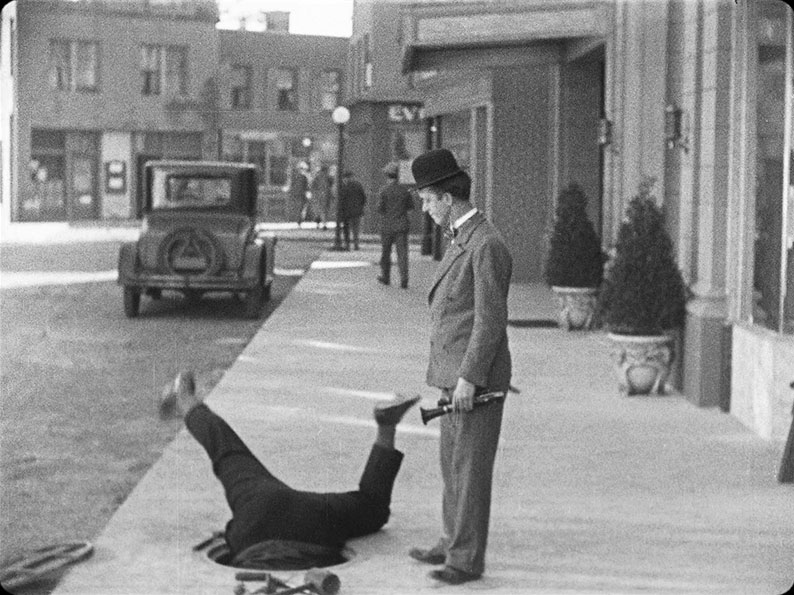
The second Stan and Ollie film directed by Edgar Kennedy, You’re Darn Tootin’ is a great deal of energetically inventive fun, and is lifted even further – at least in this iteration – by a wittily creative score by Neil Brand, who is presented with the rare opportunity by the opening orchestral performance and its mishaps to provide music that does not just accompany the action, but become an aural representation of what is unfolding on screen, mimicking the musicians, faking sound effects with instruments, and halting immediately when the performance is paused. This is carried through to Stan and Ollie’s failed attempt at busking, and peaks in a scene where the sound of them playing interferes with a rehearsal by the orchestra that they were fired from, a clash of musical performances that is perfectly captured by the soundtrack. Bravo, Mr. Brand.
| THEIR PURPLE MOMENT (1928) |
|
Here Stan and Ollie play meekly henpecked husbands who are expected to hand over every cent of their wages to their penny-pinching wives (Stan’s wife is even named Mrs. Pincher), but who each week squirrel away a few dollars for themselves. Stan hides his cash behind a cleverly constructed panel in a painting his hallway (I couldn’t help wondering who built this for him), which theoretically puts him one up on Ollie, who when visiting with his wife (Lyle Tayo) unhappily reveals that she has finally discovered where he was concealing his stash. With their wives occupied, Ollie suggests that they use Stan’s money to hit the town under the guise of a trip to the bowling alley, and just happen to arrive at the door of an upmarket restaurant just as two men are fleeing the premises to avoid paying the bill, leaving their unhappy dates (Anita Garvin and Kay Deslys) to settle up in their place. Clearly lacking the funds to do so, they make eyes at the boys, and after checking that Stan still has his wallet with him, Ollie asks a taxi driver (Leo Willis) who is also demanding payment from the women to wait, and the four head inside to enjoy a slap-up meal at Stan’s expense. Once seated, the girls display the weapons they plan to use on the men who were foolish enough to run out on them, startling Stan and Ollie, who at this point are still tragically unaware that Stan’s wife (Fay Holderness) has discovered his place of concealment and replaced the contents of his secreted wallet with money-off coupons.
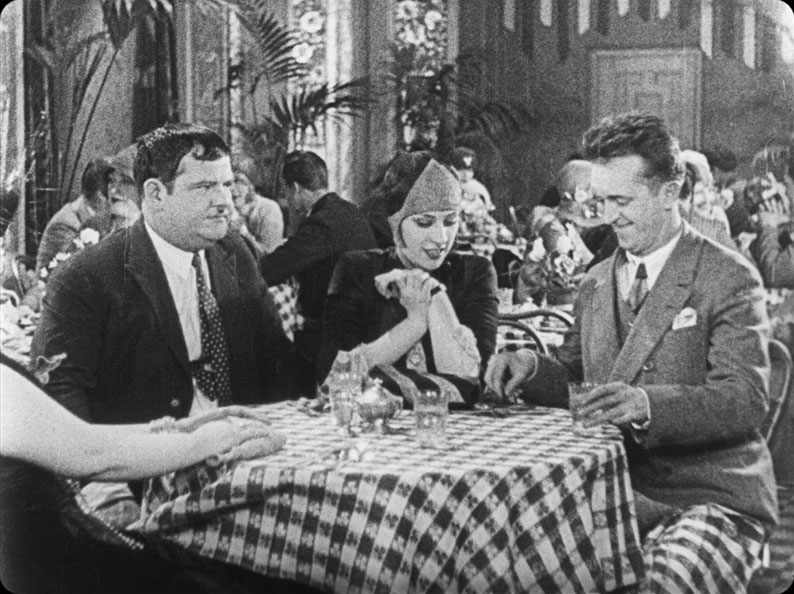
Even more clearly than the previous films in this collection, Their Purple Moment points the way to the films for which Stan and Ollie are more widely known today, at the same time functioning as an indicator of how times and attitudes have changed when it comes to the portrayal of women on screen. Here they are presented in a less than sympathetic light, coming across as either bullying and miserly (not to mention frumpy) battle-axes, opportunistic and ruthless freeloaders, or, in the case of the local Gossip (Patsy O'Byrne), viciously meanspirited scandalmongers. This is all engineered, of course, to ensure that Stan and Ollie remain in a sympathetic light when they lie to their wives and chase after younger and more superficially attractive women. That said, the fact that their wives are the ones wearing the trousers in their respective households would become a Stan and Ollie staple in their sound years, as would the presentation of the boys as humbly compliant husbands who only really come into their own when away from their respective spouses and in each other’s company.
While their earlier, more slapstick-oriented comedy lingers in the waiter who takes four identical face-first tumbles into identical cakes, as well as the chasing around and tit-for-tat food fight of the finale, for the most part this is a fully formed example of the Stan and Ollie of later years. It’s the first of their films to be directed by James Parrott, the man who would go on to helm the likes of Helpmates (1932), County Hospital (1932) and the Oscar-winning The Music Box (1932), and the first film in which Stan and Ollie both had wives. Individual elements and sequences lay the groundwork for the sound era films to follow, from their comically bashful and childlike response to the flirting of their dinner dates-to-be to the unhurried pacing and the stacking up of problems that the boys are unaware of, the aim being to build audience anticipation for how it will impact them and how they will respond. The basic setup of them treating someone to a meal that only we know that they will not be able to pay for was later nicely reworked in – once again – Below Zero, and Stan’s later penchant for doing unusual things that the overconfident Ollie then tries unsuccessfully to emulate (think the “finger wiggle” scene from their 1933 feature The Devil’s Brother) is on display here when Stan delights his date with a trick involving two spoons and a glass of water.
The pivotal sequence for me, though, consists of a long-held mid-shot of Stan when he opens his wallet to discover that his money has been replaced with coupons, one that focuses exclusively on Stan’s reaction, as his face morphs through a range of emotions –confusion, surprise, disbelief, fear and despair – some of which is directed squarely at the camera. If you’re looking for a specific moment in their early films where it really clicked with everyone involved what made Stan and Ollie’s style of comedy unique, this one simple, divinely funny shot has to be a key contender. It’s here that director Parrott, doubtless in close collaboration with Stan and supervising director Leo McCarey, demonstrated clearly that he understood the comedic value of an unhurried reaction shot, and that a comedy film doesn’t have to move at breakneck speed to be really, really funny.
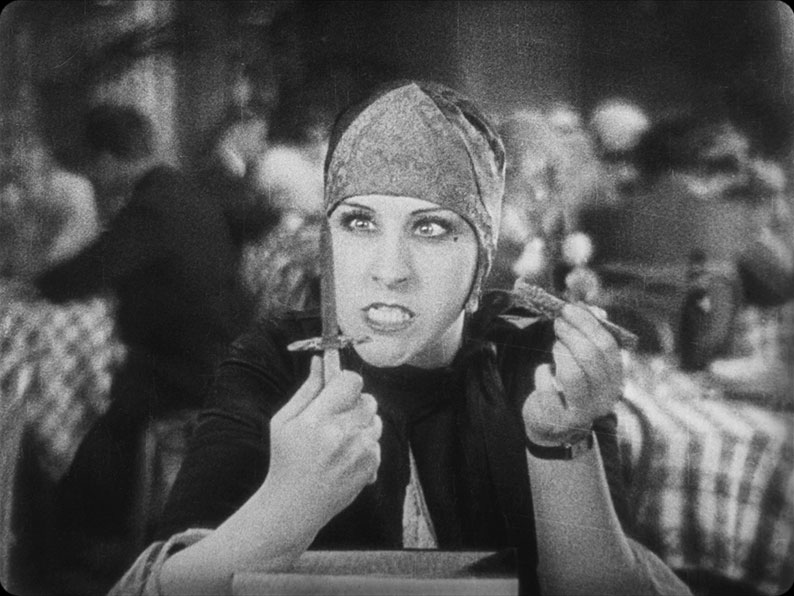
Having built so effectively to this moment of crisis for the boys, the film then ups the ante even further by having the agitated taxi driver rip the meter from his cab, enter the restaurant and plonk it down in front of a now even more traumatised Stan, only for the still unaware Ollie to invite him to sit down and tuck into one of the establishment’s excellent steaks. If that wasn’t enough, their entry to the restaurant in the company of the two girls – one of whose behind Stan brushed off with his hand after falling on top of her – was observed by the Gossip, who made an immediate and ferocious b-line for the Pincher residence to inform their wives of their husbands’ infidelity.
Their Purple Moment is a lovely little film that sets the style and tone for the duo’s future works and boasts moments of what I could only describe as quintessential Stan and Ollie comedy. For cineastes there’s also an extra small treat in the floor show performed by people of restricted growth, two of whom are played by Harry and Daisy Earles, who four years later would play lead roles in Tod Browning’s extraordinary and controversial Freaks.
Martin Chilton, The Independent, 4 January 2019
https://www.independent.co.uk/arts-entertainment/films/features/laurel-and-hardy-stan-and-ollie-film-steve-coogan-john-c-reilly-london-film-festival-a8580421.html
|